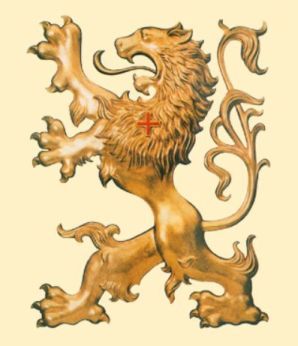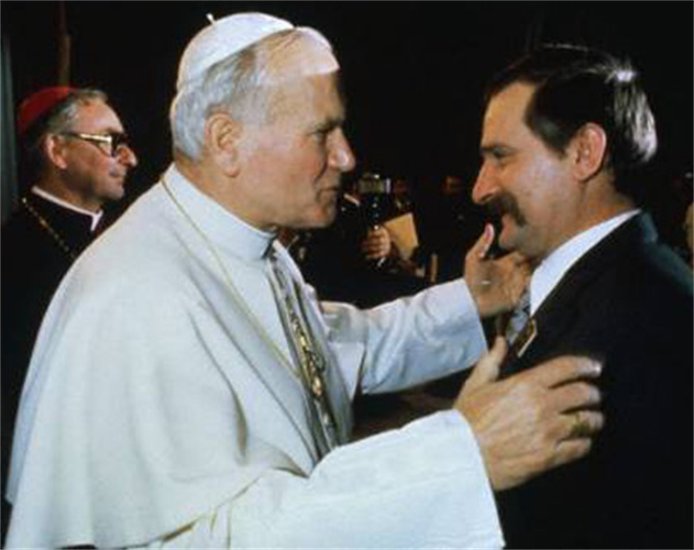|
Plinio Corrêa de Oliveira
The Genuinely Terrible and the Frightfully Fake
"Folha de S. Paulo", January 29th 1981 |
|
|
Polish labor leader Lech Walesa visited John Paul II on January 15. He received the honors of a chief of state. As soon as he arrived, he was received in private by John Paul II in his library. Immediately thereafter, his wife and stepfather were admitted into the room. And finally, his whole retinue. "John Paul II wished to grant Polish labor leader Lech Walesa ... the honors which Vatican protocol prescribes for chiefs of state, and which were formerly reserved for sovereigns of the Holy Roman Empire. In fact, with yesterday's audience, Pope Wojtyla gave Walesa and the 'Solidarity' union a true and genuine investiture, along with an indication of the line he should follow when he said that the rise of this union fits into the framework of efforts made in Poland during the weeks of last autumn, which were not against anyone, but were and are exclusively for the common good." This is what the Roman daily L'Unità (1/16/81), the official organ of the Italian Communist Party itself, commented with a mixture of elation and pride. Why this enthusiasm? Why are they ravished at the "investiture" given to Walesa, that is, to the leader of a movement that appears to create so many obstacles for the puppets that Moscow has billeted in the Warsaw government? Mystery, mystery ... How mysterious the Kremlin is and has been, from the somber times of Ivan the Terrible to Leonid Brezhnev the Feared (by everyone except the heroic Afghans).
I was talking about what happened in John Paul II's library. The high point of Walesa's visit to the Supreme Pontiff followed immediately. L'Osservatore Romano (1/16/81) reported that after the library reception Walesa's audience continued "in the Consistory Hall with the presence of numerous representatives of the Polish community residing in Italy and of journalists from various Italian and foreign newspapers. "Yes, in the legendary Consistory Hall, one of the Vatican's most celebrated and sumptous ones, which prolongs today the splendors of the Seventeenth Century when it was inaugurated. This hall is known the world over, for there the Sovereign Pontiffs convene the most august of senates, that is the Sacred College of Cardinals. I really cannot imagine that today one could do more to give prestige to a mere private citizen. While giving my reflection a discreet intonation out of respect, I must say that I didn't even imagine so much was possible. But, what a nuanced matter! Here an observation rich in psychological significance and in reach should be made. This is true above all because, as I already said in the previous article, we arc dealing with the Holy See whose diplomacy is rightly considered the most famous in the world. To the extent the metaphor is licit, I would say that the audience granted by John Paul II is comparable to a bright lamp turned on beside Walesa. But the Vatican's semi‑official newspaper ‑John Paul II's own newspaper ‑ puts a shade on it. Everyone knows that in up‑to‑date newspapers (without the least doubt L'Osservatore Romano is one of them) every headline, nay, every word, is care fully counted, measured, and weighed. Endless subtleties may go into the section of the page where a news item is published and even into the selection of its proper place on the page. These are very objective subtleties, because when it comes to propaganda everything counts. True, L'Osservatore Romano gave Walesa's visit no small publicity, and it couldn't have been otherwise. But this publicity does not have the grandiloquence that the organ of the Italian Communist Party devoted to the same matter. Thus: 1. In L'Osservatore Romano of January 16, the news about the audience with John Paul II appears with a photograph at the top right of the front page. But the news takes up only three of seven columns. Right beside it, also occupying three columns and at the top of the page, is another report about another audience granted by the Supremc Pontiff. This was for the "participants in the First Congress for the Family in Africa and in Europe." How subjects unequally important are nevertheless placed together on the same shelf ... That was the wrapping. 2. Now for the substance. While the very fact of Walesa and his people's reception in the Consistory Hall shone so much in Poland and in the world, L'Osservatore Romano presented it quite soberly. The news consisted mainly of the text of the Pontiff's discourse in Polish and in Italian. How sober the language of L'Osservatore Romano is in comparison with the communist paper's bombastic references to the Pontiff's investiture of Walesa and the parallel it makes between Walesa and the Emperors of the Holy Roman Empire! Why so much sobriety (which the newspaper keeps until the end of the report on page two…) about such a sparkling fact? On the other hand, why does the Italian Communist Party's publicity use a magnifying glass on the brilliance that favored Walesa‑Enigma, mystery. Perhaps, it's not too much to add, disconcerting. 3. Walesa greeted John Paul II seeking guidelines: "We await your counsels and we will always serve you faithfully" (cf. Avvenire, official spokesman of the Italian episcopate, 1/16/81). This request was followed by an allocution in which the Supreme Pontiff gives his guidelines to Walesa, which could be summed up in the formula, fearlessness and moderation ‑ with a discreet but definite emphasis on moderation. Thus it became clear that Walesa intends to act along the lines desired by John Paul II and that the latter has hopes in the "Solidarity" leader's fidelity. Here is the very core of the exchange of speeches, the central point which gives meaning to everything else. However, L'Osservatore failed to show this clearly simply because it reproduces only the less significant parts of Walesa's salutation. Why was the extremely competent L'Osservatore Romano omissive in precisely this key point? 4. For its part, the communist paper L'Unità also fails to publish Walesa's request for guidelines, even though this request helps considerably in characterizing what it enthusiastically calls "investiture." Why this omission? Mysteries. Here again, mysteries. And once more there comes to my mind the comparison between the mad and the wicked but authentic dreadfulness of the Sixteenth Century and the inflated, doubtful, half real and half folkloric dreadfulness of the knavish and banal Feared One of the Twentieth Century. |
|


